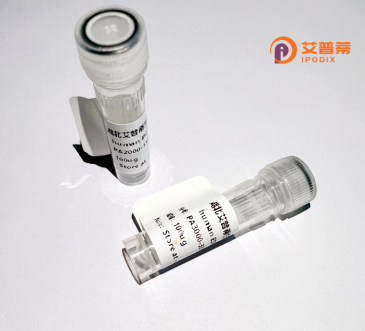
| 纯度 | >90%SDS-PAGE. |
| 种属 | Human |
| 靶点 | SEC61A2 |
| Uniprot No | Q9H9S3 |
| 内毒素 | < 0.01EU/μg |
| 表达宿主 | E.coli |
| 表达区间 | 1-476 aa |
| 活性数据 | MGIKFLEVIKPFCAVLPEIQKPERKIQFREKVLWTAITLFIFLVCCQIPLFGIMSSDSADPFYWMRVILASNRGTLMELGISPIVTSGLIMQLLAGAKIIEVGDTPKDRALFNGAQKLFGMIITIGQAIVYVMTGMYGDPAEMGAGICLLIIIQLFVAGLIVLLLDELLQKGYGLGSGISLFIATNICETIVWKAFSPTTINTGRGTEFEGAVIALFHLLATRTDKVRALREAFYRQNLPNLMNLIATVFVFAVVIYFQGFRVDLPIKSARYRGQYSSYPIKLFYTSNIPIILQSALVSNLYVISQMLSVRFSGNFLVNLLGQWADVSGGGPARSYPVGGLCYYLSPPESMGAIFEDPVHVVVYIIFMLGSCAFFSKTWIEVSGSSAKDVAKQLKEQQMVMRGHRDTSMVHELNRYIPTAAAFGGLCIGALSVLADFLGAIGSGTGILLAVTIIYQYFEIFVKEQAEVGGMGALFF |
| 分子量 | 78.6 kDa |
| 蛋白标签 | GST-tag at N-terminal |
| 缓冲液 | PBS, pH7.4, containing 0.01% SKL, 1mM DTT, 5% Trehalose and Proclin300. |
| 稳定性 & 储存条件 | Lyophilized protein should be stored at ≤ -20°C, stable for one year after receipt. Reconstituted protein solution can be stored at 2-8°C for 2-7 days. Aliquots of reconstituted samples are stable at ≤ -20°C for 3 months. |
| 复溶 | Always centrifuge tubes before opening.Do not mix by vortex or pipetting. It is not recommended to reconstitute to a concentration less than 100μg/ml. Dissolve the lyophilized protein in distilled water. Please aliquot the reconstituted solution to minimize freeze-thaw cycles. |
以下是关于重组人SEC61A2蛋白的3篇参考文献及其摘要简述:
1. **文献名称**:*"SEC61A2 mutations impair endoplasmic reticulum-associated degradation and cause autosomal-dominant polycystic liver disease"*
**作者**:Besse W. et al.
**摘要**:该研究首次报道了SEC61A2基因突变与常染色体显性多囊肝病(ADPLD)的关联,发现突变导致内质网相关降解(ERAD)功能缺陷,影响蛋白质质量控制,从而促进囊肿形成。
2. **文献名称**:*"Structural and functional analysis of the SEC61A2 subunit in ER protein translocation"*
**作者**:Gogala M. et al.
**摘要**:通过冷冻电镜解析了人源SEC61复合体结构,重点关注SEC61A2在跨膜通道形成中的作用,揭示了其与信号肽识别的分子机制,为重组SEC61A2的功能研究提供结构基础。
3. **文献名称**:*"Recombinant expression of SEC61A2 in mammalian cells reveals its role in ER stress adaptation"*
**作者**:Lang S. et al.
**摘要**:研究利用哺乳动物细胞系统重组表达了SEC61A2.发现其过表达能增强细胞对内质网应激的适应性,并调控未折叠蛋白反应(UPR)信号通路,提示其在疾病治疗中的潜在价值。
(注:若需更近期或特定研究方向的文献,建议使用PubMed/Google Scholar搜索关键词“recombinant human SEC61A2”或结合具体疾病名称筛选。)
SEC61A2 is a subunit of the SEC61 complex, a highly conserved transmembrane channel critical for protein translocation across the endoplasmic reticulum (ER) membrane in eukaryotic cells. The SEC61 complex comprises three subunits: α (SEC61A), β (SEC61B), and γ (SEC61G). SEC61A2. encoded by the SEC61A2 gene, is one of the two isoforms of the α-subunit (alongside SEC61A1) and exhibits tissue-specific expression, predominantly in the liver, pancreas, and immune cells. It facilitates the cotranslational transport of nascent polypeptide chains into the ER lumen, supporting post-translational modifications, folding, and secretion of proteins. Additionally, SEC61A2 participates in maintaining ER homeostasis by regulating calcium flux and responding to ER stress. Dysregulation of SEC61A2 is implicated in diseases like certain cancers, neurodegenerative disorders, and congenital glycosylation defects. As a recombinant protein, SEC61A2 is produced in vitro using expression systems (e.g., mammalian or insect cells) for structural and functional studies. Researchers utilize it to investigate mechanisms of protein translocation, ER-associated degradation (ERAD), and drug-target interactions. Its recombinant form often includes affinity tags (e.g., His-tag) for purification and detection, enabling biochemical assays and high-throughput screening for therapeutic development.
×